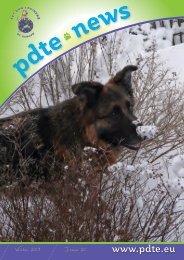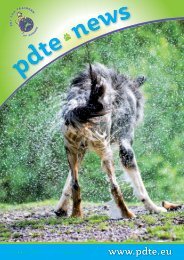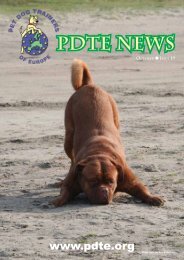PDTE Newsletter July 2020
You also want an ePaper? Increase the reach of your titles
YUMPU automatically turns print PDFs into web optimized ePapers that Google loves.
BREED STUDY
Nova Scotia Duck Tolling Retriever // Toller
• origin
• height
• weight
• coat
• color
• age
• FCI #
Canada
45 - 51 cm
17 - 23 kg
water repellent double coat with soft dense undercoat
any shade of red, often with white marks
10 - 14 years
312 - Retrievers - Flushing Dogs - Water Dogs
Special feature:
developed to resemble a fox in appearance and behaviour
History
The breed was developed in Nova Scotia,
Canada around the beginning of the
19th century. The toller was originally
referred to as the Little River Duck Dog
before being officially recognized by the
Canadian Kennel Club in 1945 as a pure
bred dog. The toller is a mixture of retrievers,
spaniels, setters, and possibly a
farm collie mix breed, although this has
yet to be confirmed.
General appearance
The Nova Scotia Duck Tolling Retriever is
a medium-sized gundog. It is the smallest
of the retrievers. The Nova Scotia
Duck Tolling Retrievers were developed
to resemble a fox. Foxes are the natural
enemies of ducks, yet many species of
duck will flock to a fox when they see it
onshore. Tollers often have white tail
tips, which aids in the hunter’s ability to
see the dog’s location in the water.
The Toller was bred to retrieve from icy
waters and has an appropriate for this
coat. The legs have webbed feet, which
helps Tollers swim.
Characteristics
Nova Scotia Duck Tolling Retrievers
are known to be very smart, curious,
outgoing and affectionate dogs. Like
many Gun dogs, Tollers like to be part of
one team with their owner and do joint
activities.
Tollers are named for their ability to
entice or lure waterfowl within gunshot
range, called “tolling”. Duck-hunters
work with this breed at the water’s edge.
They throw a stick or a ball for the dog
to fetch. It scampers along in a highly
conspicuous way, jumping, playing and
leaping, but without barking. It may do
this repeatedly – often disappearing
from sight and then suddenly reappearing.
Its unusual activity and white markings
pique the curiosity of ducks and
geese which swim over to investigate.
When the birds are close, the hunter
calls the dog back to the blind then rises
putting the birds to flight allowing the
hunter a shot. The Toller then retrieves
any downed birds. They are particularly
suited for retrieving in cold water
climates because of their water repellent
double coat.
Some Tollers have a unique sounding
bark known as the “Toller scream”, a
high-pitched howl-like sound.
How to share life
Please keep in mind that as retrievers,
Tollers will take things in their mouth a
lot. Please note it’s a normal behavior!
Make your house dog-safe, move all pre-
cious objects out of your dog’s reach. But
please have toys that Toller can hold –
they’ll need it to calm down sometimes.
Tollers are happiest when they have a
meaningful job to do. Living inside the
house close to family is also very important
for them. Tollers would love to take
part in your daily life and help you with
important tasks – teach your dog to find
and bring you different objects you may
need, they’ll enjoy that.
Despite being great working dogs, Nova
Scotia Duck Tolling Retriever would not
benefit from excessive exercise. Any
chasing activities (balls, frisbees) are also
not the best choice as these increase
general stress levels of the dog. Instead,
Tollers will be happy to explore new or
enriched environments, do tracking,
treat search and other kinds of nose
work. Of course, Tollers will enjoy hunting
with you as they were bred for this.
Care - Health
A good brushing once a week is enough
to keep the coat in good shape. Bathing
should be done on an “as needed” basis.
Tollers are a relatively healthy breed.
Tollers can have eye issues including
progressive retinal atrophy, Collie eye
anomaly and cataracts. Addison’s Disease
and autoimmune thyroiditis have
also been diagnosed in the breed.
July 2020
PDTE Newsletter
25

















